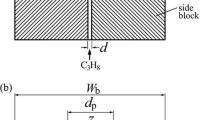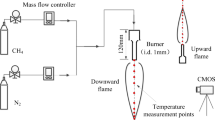Abstract
Effects of small backward inclination on the flame behaviors and thermochemical structures of a stack-issued transverse combusting gaseous fuel jet in crossflow were examined in a wind tunnel. The wind tunnel was used to supply the crossflow. A combusting jet was released vertically into the crossflow through a burner tube to serve as the benchmark. The case that the jet released at a small backward inclination angle of 20o was studied for comparison with the benchmark. The jet-to-crossflow momentum flux ratio ranged from 0.005 to 12. The flame behaviors were studied with photography techniques while the temperature fields were probed using a fine-wire R-type thermocouple. The combustion product concentrations were detected with a gas analyzer. It was found that the flames of the jet issued vertically into the crossflow never detached from the burner tube tip, whereas those of the jet issued from a burner tube at a small backward inclination angle may detach and stabilize above the burner tube exit at high fuel jet velocity before blow-off. The slightly backward inclined combusting jet in crossflow presented slower development to turbulent flames as the jet velocity increased and longer flame length than the flames of the vertically issued jet in crossflow. However, injecting the fuel jet at a small backward inclination angle into a crossflow may lead to a reduction in the emission levels of carbon monoxide and nitric oxide when compared with fuel jets released vertically.




















Similar content being viewed by others
Explore related subjects
Discover the latest articles and news from researchers in related subjects, suggested using machine learning.Abbreviations
- b f :
-
Flame span width as observed from the top views, mm.
- C CO :
-
Concentrations of carbon monoxide.
- C NO :
-
Concentrations of nitric oxide.
- C UHC :
-
Concentrations of unburned hydrocarbons.
- D :
-
Outer diameter of burner tube, 6.4 mm.
- d :
-
Inner diameter of burner tube, 5.0 mm.
- L :
-
Length of burner tube, 510 mm.
- L bf :
-
Blue flame length, mm.
- l tf :
-
Total visible flame length, mm.
- R :
-
Jet-to-crossflow momentum flux ratio (= ρjuj2/ρwuw2).
- Rej :
-
Jet Reynolds number (= ujd/νj).
- Rew :
-
Crossflow Reynolds number (= uwD/νw).
- T :
-
Time-averaged flame temperature, °C.
- u j :
-
Average jet velocity at exit of burner tube (4Qj/πd2), m/s.
- u w :
-
Crossflow velocity, m/s.
- W rf :
-
Recirculation flame length, mm.
- x :
-
Cartesian coordinate in axial direction.
- y :
-
Cartesian coordinate in cross-stream direction.
- z :
-
Vertical coordinate.
- θ :
-
Backward-inclination angle of burner tube evaluated from the direction normal to the crossflow.
- ρ j :
-
Fuel jet density, kg/m3.
- ρ w :
-
Density of crossflow air, kg/m3.
- ν j :
-
Kinematic viscosity of fuel jet, m2/s.
- ν j :
-
Kinematic viscosity of crossflow air, m2/s.
References
Escudier MP (1971) Aerodynamics of a burning turbulent gas jet in a crossflow. Combust Sci Technol 4:293–301. https://doi.org/10.1080/00102207108952495
Karagozian AR (1986) The flame structure and vorticity generated by a chemically reactingtransverse jet. AIAA J 24:1502–1507. https://doi.org/10.2514/3.9472
Kolla H, Grout RW, Gruber A, Chen JH (2012) Mechanisms of flame stabilization and blowout in a reacting turbulent hydrogen jet in cross-flow. Combust Flame 159:2755–2766. https://doi.org/10.1016/j.combustflame.2012.01.012
Steinberg AM, Sadanandan R, Dem C, Kutne P, Meier W (2013) Structure and stabilization of hydrogen jet flames in cross-flows. P Combust Inst 34:1499–1507. https://doi.org/10.1016/j.proci.2012.06.026
Wagner JA, Grib SW, Renfro MW, Cetegen BM (2015) Flowfield measurements and flame stabilization of a premixed reacting jet in vitiated crossflow. Combust Flame 162:3711–3727. https://doi.org/10.1016/j.combustflame.2015.07.010
Hasselbrink EF, Mungal MG (2001) Transverse jets and jet flames. Part 1. Scaling laws for strong transverse jets. J Fluid Mech 443:1–25. https://doi.org/10.1017/s0022112001005146
Askari A, Bullman SJ, Fairweather M, Swaffield F (1990) The concentration field of a turbulent jet in a cross-wind. Combust Sci Technol 73:463–478. https://doi.org/10.1080/00102209008951663
Bandaru RV, Turns SR (2000) Turbulent jet flames in a crossflow: effects of some jet, crossflow, and pilot-flame parameters on emissions. Combust Flame 121:137–151. https://doi.org/10.1016/s0010-2180(99)00166-2
Birch AD, Brown DR, Fairweather M, Hargrave GK (1989) An experimental study of a turbulent natural gas jet in a cross-flow. Combust Sci Technol 66:217–232. https://doi.org/10.1080/00102208908947151
Botros PE, Brzustowski TA (1979) An experimental and theoretical study of the turbulent diffusion flame in cross-flow. Symp Combust 17:389–398. https://doi.org/10.1016/s0082-0784(79)80040-5
Bourguignon E, Johnson MR, Kostiuk LW (1999) The use of a closed-loop wind tunnel for measuring the combustion efficiency of flames in a cross flow. Combust Flame 119:319–334. https://doi.org/10.1016/s0010-2180(99)00068-1
Brzustowski TA (1976) Flaring in the energy industry. Prog Energy Combust Sci 2:129–141. https://doi.org/10.1016/0360-1285(76)90009-5
Brzustowski TA, Gollahalli SR, Sullivan HF (1975) The turbulent hydrogen diffusion flame in a cross-wind. Combust Sci Technol 11:29–33. https://doi.org/10.1080/00102207508946681
Fairweather M, Jones WP, Lindstedt RP, Marquis AJ (1991) Predictions of a turbulent reacting jet in a cross-flow. Combust Flame 84:361–375. https://doi.org/10.1016/0010-2180(91)90012-z
Gollahalli SR, Brzustowski TA, Sullivan HF (1975) Characteristics of a turbulent propane diffusion flame in a cross-wind. Trans Canad Mech Eng 3:205–214
Gollahalli SR, Nanjundappa B (1995) Burner wake stabilized gas jet flames in cross-flow. Combust Sci Technol 109:327–346. https://doi.org/10.1080/00102209508951908
Gollahalli SR, Pardiwalla D (2002) Comparison of the flame characteristics of turbulent circular and elliptic jets in a crossflow. J Energy Resour Technol 124:197–203. https://doi.org/10.1115/1.1488170
Huang RF, Kimilu RK, Hsu CM (2016) Effects of jet pulsation intensity on a wake-stabilized non-premixed jet flame in crossflow. Exp Thermal Fluid Sci 78:153–166. https://doi.org/10.1016/j.expthermflusci.2016.06.002
Johnson MR, Kostiuk LW (2000) Efficiencies of low-momentum jet diffusion flames in crosswinds. Combust Flame 123:189–200. https://doi.org/10.1016/s0010-2180(00)00151-6
Johnson MR, Wilson DJ, Kostiuk LW (2001) A fuel stripping mechanism for wake-stabilized jet diffusion flames in crossflow. Combust Sci Technol 169:155–174. https://doi.org/10.1080/00102200108907844
Kalghatgi GT (1981) Blow-out stability of gaseous jet diffusion flames part II: effect of cross wind. Combust Sci Technol 26:241–244. https://doi.org/10.1080/00102208108946965
Kostiuk LW, Mejeski AJ, Poudenx P, Johnson MR, Wilson DJ (2000) Scaling of wake-stabilized jet diffusion flames in a transverse air stream. Proc Combust Inst 28:553–559. https://doi.org/10.1016/s0082-0784(00)80255-6
L Ellzey J, Berbe JG, Tay EZF, Foster DE (1990) Total soot yield from a propane diffusion flame in cross-flow. Combust Sci Technol 71:41–52. https://doi.org/10.1080/00102209008951623
Majeski AJ, Wilson DJ, Kostiuk LW (2004) Predicting the length of low-momentum jet diffusion flames in crossflow. Combust Sci Technol 176:2001–2025. https://doi.org/10.1080/00102200490514769
Huang RF, Chang JM (1994) The stability and visualized flame and flow structures of a combusting jet in cross flow. Combust Flame 98:267–278. https://doi.org/10.1016/0010-2180(94)90241-0
Huang RF, Yang MJ (1996) Thermal and concentration fields of burner-attached jet flames in cross flow. Combust Flame 105:211–224. https://doi.org/10.1016/0010-2180(95)00193-X
Huang RF, Chang JM (1994) Coherent structure in a combusting jet in crossflow. AIAA J 32:1120–1125. https://doi.org/10.2514/3.12110
Kimilu RK, Huang RF, Hsu CM (2017) High-frequency excited non-premixed jet flame in crossflow. J Mar Sci Technol Taiwan 25:96–107. https://doi.org/10.6119/Jmst-016-0928-1
Savas O, Huang RF, Gollahalli SR (1997) Structure of the flow field of a nonpremixed gas jet flame in cross-flow. J Energy Resour Technol 119:137–144. https://doi.org/10.1115/1.2794977
Kalghatgi GT (1982) Blow-out stability of gaseous jet diffusion flames: part III - effect of burner orientation to wind direction. Combust Sci Technol 28:241–245. https://doi.org/10.1080/00102208208952558
Han D, Mungal MG (2003) Simultaneous measurements of velocity and CH distribution. Part II: deflected jet flames. Combust Flame 133:1–17. https://doi.org/10.1016/s0010-2180(02)00551-5
Luo MC (1997) Effects of radiation on temperature measurement in a fire environment. J Fire Sci 15:443–461. https://doi.org/10.1177/073490419701500602
Huang RF, Wang SM (1999) Characteristic flow modes of wake-stabilized jet flames in a transverse air stream. Combust Flame 117:59–77. https://doi.org/10.1016/S0010-2180(98)00070-4
Khouygani MG, Huang RF, Hsu CM (2015) Flow characteristics in median plane of a backward-inclined elevated transverse jet. Exp Thermal Fluid Sci 62:164–174. https://doi.org/10.1016/j.expthermflusci.2014.12.009
Andreopoulos J (1989) Wind tunnel experiments on cooling tower plumes: part 1—in uniform crossflow. J Heat Transf 111:1–8. https://doi.org/10.1115/1.3250809
Huang RF, Lan J (2005) Characteristic modes and evolution processes of shear-layer vortices in an elevated transverse jet. Phys Fluids 17:1–13. https://doi.org/10.1063/1.1852575
Huang RF, Hsieh RH (2002) An experimental study of elevated round jets deflected in a crosswind. Exp Thermal Fluid Sci 27:77–86. https://doi.org/10.1016/s0894-1777(02)00217-0
Huang RF, Hsieh RH (2003) Sectional flow structures in near wake of elevated jets in a crossflow. AIAA J 41:1490–1499. https://doi.org/10.2514/2.2099
Han DH, Orozco V, Mungal MG (2000) Gross-entrainment behavior of turbulent jets injected obliquely into a uniform crossflow. AIAA J 38:1643–1649. https://doi.org/10.2514/2.1147
Kalghatgi GT (2007) Blow-out stability of gaseous jet diffusion flames. Part I: in still air. Combust Sci Technol 26:233–239. https://doi.org/10.1080/00102208108946964
Hu G, Tse KT, Kwok KCS, Zhang Y (2015) Large eddy simulation of flow around an inclined finite square cylinder. J Wind Eng Ind Aerodyn 146:172–184. https://doi.org/10.1016/j.jweia.2015.08.008
Wang Q, Hu L, Yoon SH, Lu S, Delichatsios M, Chung SH (2015) Blow-out limits of nonpremixed turbulent jet flames in a cross flow at atmospheric and sub-atmospheric pressures. Combust Flame 162:3562–3568. https://doi.org/10.1016/j.combustflame.2015.06.012
Andreopoulos J, Rodi W (1984) Experimental investigation of jets in a crossflow. J Fluid Mech 138:93–127. https://doi.org/10.1017/s0022112084000057
Keffer JF, Baines WD (1963) The round turbulent jet in a cross-wind. J Fluid Mech 15:481–496. https://doi.org/10.1017/s0022112063000409
Kimilu RK, Huang RF, Hsu CM (2016) Non-premixed burner-attached jet flames in crossflow pulsed at resonance frequency. J Propuls Power 33:1332–1350. https://doi.org/10.2514/1.B36270
Liu Y, Sun X, Sethi V, Nalianda D, Li Y-G, Wang L (2017) Review of modern low emissions combustion technologies for aero gas turbine engines. Prog Aerosp Sci 94:12–45. https://doi.org/10.1016/j.paerosci.2017.08.001
Author information
Authors and Affiliations
Corresponding author
Ethics declarations
Conflict of interest
On behalf of all authors, the corresponding author states that there is no conflict of interest.
Additional information
Publisher’s Note
Springer Nature remains neutral with regard to jurisdictional claims in published maps and institutional affiliations.
The original version of this article was revised: During typesetting of the article, the less than symbols (<) were overlooked.
Rights and permissions
About this article
Cite this article
Mosiria, D.B., Huang, R.F. & Hsu, C.M. Effects of small backward inclination on characteristics of a stack-issued combusting transverse jet in crossflow. Heat Mass Transfer 55, 733–751 (2019). https://doi.org/10.1007/s00231-018-2457-5
Received:
Accepted:
Published:
Issue Date:
DOI: https://doi.org/10.1007/s00231-018-2457-5




